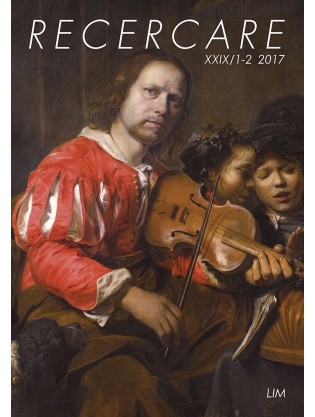 View larger
View larger
Et iste erat valde musicus: Pope Leo X, composer
Online only
| Author | Anthony M. Cummings – Michał Gondko |
| Series | Recercare - Rivista per lo studio e la pratica della musica antica - Journal for the study and practice of early music |
| Nr. | XXIX/1-2 2017 |
| Size | 17×24, pp. 284 |
| Year | 2017 |
| ISBN | 9788870968996 |
Pope Leo x (reigned 1513–1521), Giovanni di Lorenzo il Magnifico de’ Medici, is known as one of the great patrons of music in European history and himself a composer of some note. However, his status as composer has not yet been fully or systematically considered. A new, hitherto unknown reference to one of his (lost) compositions now prompts a thorough such consideration. Leo’s known compositions are five in number: three polyphonic motets on Latin sacred texts; one setting of a French secular text; and one instrumental canon. Although scarcely qualifying for inclusion among the finest surviving compositions of the early Cinquecento, they are nonetheless creditable compositions for a musical amateur. Such attainments would seem to demand some explanation as to how Leo came by the compositional abilities required to produce such compositions. French musicologist André Pirro had once suggested that Leo had to have studied with Heinrich Isaac, easily the most distinguished composer of the Florence of Leo’s youth. Although there is no substantiating evidence for Pirro’s claim, it is certainly the most plausible conjecture one could make. The article reviews all the pertinent evidence documenting the close relationship that existed between Isaac and the Medici family, which would have afforded an opportunity for Leo to study with the composer. Leo’s works are in some of the same genres as one finds in Isaac’s compositional output. The article also conjectures about another source of Leo’s passion for polyphonic composition.
The implications of Leo’s fondness for polyphonic music are explored. He seems to have called for a greatly expanded use of polyphony in the liturgical ceremonies of the Papal Chapel choir during his pontificate, so much so that his traditionalist master of ceremonies objected. And several of the composers in his employ composed polyphonic settings of texts that figured prominently in the liturgy of Leo’s time. But although the enhancement of polyphonic practices in the sacred realm is notable, even more important are the instances of polyphonic treatment of Italian secular texts. There is a thesis that the Italian madrigal of the sixteenth century emerged in Medici circles, and there is some evidence that Leo’s musical interests and patronage practices indeed may have been responsible for the application of a polyphonic technique to secular texts of the type that figured in the madrigal repertory. More specifically, an important composer of the transitional phase — Michele Pesenti da Verona — appears to have undergone a creative transformation under Leo’s influence. Pesenti’s earliest secular works, composed for the Este court, are in the frottola tradition: A solo voice sings to the accompaniment of a consort of bowed string instruments or a lute. But Pesenti’s employment conditions then change – he finds himself at Leo’s court – and toward the end of his career as a composer, he composes polyphonic settings of madrigalian verse for an ensemble of voices who sing fully-texted proto-madrigals.
The article concludes with the first complete-works edition of Leo’s compositional output. There is a thorough inventory of the compositions, with information on the manuscript and printed sources, folio numbers, and composer attributions; texts and translations of the vocal compositions; a through accounting of the variant readings in the critical notes; and scholarly editions of the extant compositions. From the introductory historical material and the musical editions, a picture emerges of Leo’s profile as composer, the sources of his compositional abilities, and the importance for the period musical culture of his dedication to contrapuntal practice.
Michał Gondko is founder and artistic co-director of La Morra, an ensemble specializing in performance of medieval and Renaissance music. He has earned the M.A. at the Schola Cantorum Basiliensis (Basel), where he studied lute with Hopkinson Smith. La Morra’s recordings have won such marks of musical distinction as Diapason d’Or, the Jahrespreis der deutschen Schallplattenkritik, the Noah Greenberg Award (for the production of the CD The Lion’s ear: a tribute to Leo x, musician among popes) as well as Gramophone and International Classical Music Award nominations. contact@lamorra.info

